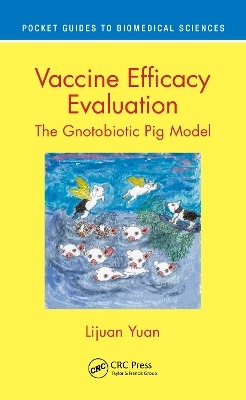
Vaccine Efficacy Evaluation
CRC Press (Verlag)
978-1-032-23474-8 (ISBN)
Testing the immunogenicity, protective efficacy and safety in animal models is a crucial step in vaccine development. Pigs raised in germ-free environments, called gnotobiotic (Gn) pigs, are one of the most useful animal models for testing vaccines. The Gn pig model is a widely accepted model for studying pathogenesis and immunity and an ideal model for pre-clinical testing for the safety and efficacy of enteric viral vaccines. Through these studies and others, the Gn pig model has been established as the most reliable animal model for pre-clinical evaluation of human rotavirus and norovirus vaccines. This book provides detailed information on establishing Gn pig models, determining a proper virus inoculum pool and challenge dose, measuring protection and calculating efficacy, and delineating intestinal and systemic immune responses associated with the protection.
Key Features
Provides a natural history of human rotavirus and norovirus infection in Gn pigs
Establishes the optimal virus challenge doses in Gn pigs for vaccine evaluation
Evaluates various candidate rotavirus and norovirus vaccines
Discusses human gut microbiota transplanted Gn pig models
Documents the role of probiotics and rice bran as prophylactics and vaccine adjuvants
Lijuan Yuan is a Professor of Virology and Immunology in the Virginia-Maryland Vet Med’s Department of Biomedical Sciences & Pathobiology. Dr. Yuan studies the interactions between enteric viruses and the host immune system. Her lab's research interests are focused on the pathogenesis and innate and adaptive immune responses induced by enteric viruses, especially noroviruses and rotaviruses, and on the development of safer and more effective vaccines as well as passive immune prophylaxis and therapeutics against viral gastroenteritis. These studies utilize wild-type, gene knock-out, and human gut microbiota transplanted gnotobiotic pig models of human rotavirus and norovirus infection and diseases and cell culture model of rotavirus infection. Currently, the Yuan lab is evaluating the immunogenicity and protective efficacy of several candidate novel rotavirus and norovirus vaccines and engineered probiotic yeast Saccharomyces boulardii secreting multi-specific single-domain antibodies as novel prophylaxis against both noroviruses and Clostridioides difficile toxins. See: https://vetmed.vt.edu/people/faculty/yuan-lijuan.html
Preface. Acknowledgments. About the Author. Introduction. Establishment of Gn Pig Model of HRV Infection and Diarrhea: Infectivity and Pathogenesis of HRV in Gn Pigs. Establishment of Gn Pig Model of HuNoV Infection and Diarrhea. Evaluation of Live Oral and Inactivated Intramuscular HRV Vaccines in Gn Pigs. Virus-like Particles Given Intranasally or DNA Plasmids Given Intramuscularly Failed to Induce Any Protection in Gn Pigs. Prime-Boost Rotavirus Vaccine Regimens Are Highly Effective. Rotavirus P2-VP8* and P24-VP8* Intramuscular Vaccines Evaluated in Gn Pigs. Norovirus P Particle and VLP Vaccines Evaluated in Gn Pig Model of GII.4 HuNoV Infection and Diarrhea. Simvastatin Reduces Protection and Intestinal T cell Responses Induced by a Norovirus P Particle Vaccine in Gnotobiotic Pigs. Dissecting Importance of B Cells versus T Cells in Rotavirus Vaccine-Induced Immunity Using Gene Knockout Gn Pigs. Human Gut Microbiota-Transplanted Gn Pig Models for HRV Infection. Probiotics Modulate Adaptive Immune Responses to Oral HRV Vaccines in HGM Transplanted Gn Pigs. Probiotics Modulate Cell Signaling Pathway and Innate Cytokine Responses to Oral HRV Vaccine in HGM-Transplanted Gn Pigs. Probiotics as HRV Vaccine Adjuvants in Gn Pigs. Rice Bran as a Vaccine Adjuvant and as Prebiotics in Reducing Viral Diarrhea. References. Index.
| Erscheinungsdatum | 14.04.2022 |
|---|---|
| Reihe/Serie | Pocket Guides to Biomedical Sciences |
| Zusatzinfo | 30 Tables, black and white; 10 Line drawings, color; 58 Line drawings, black and white; 10 Illustrations, color; 58 Illustrations, black and white |
| Verlagsort | London |
| Sprache | englisch |
| Maße | 133 x 203 mm |
| Gewicht | 540 g |
| Themenwelt | Medizin / Pharmazie ► Medizinische Fachgebiete ► Pharmakologie / Pharmakotherapie |
| Studium ► Querschnittsbereiche ► Infektiologie / Immunologie | |
| Naturwissenschaften ► Biologie ► Genetik / Molekularbiologie | |
| ISBN-10 | 1-032-23474-1 / 1032234741 |
| ISBN-13 | 978-1-032-23474-8 / 9781032234748 |
| Zustand | Neuware |
| Informationen gemäß Produktsicherheitsverordnung (GPSR) | |
| Haben Sie eine Frage zum Produkt? |
aus dem Bereich


